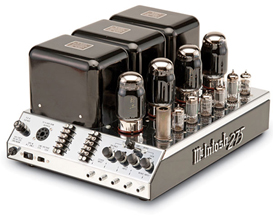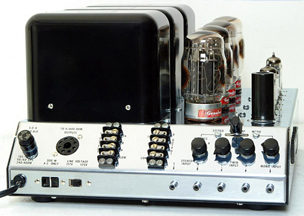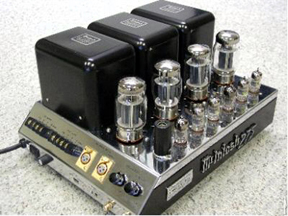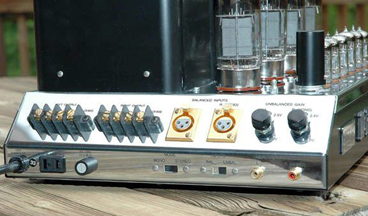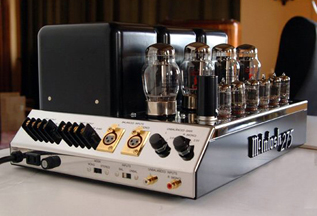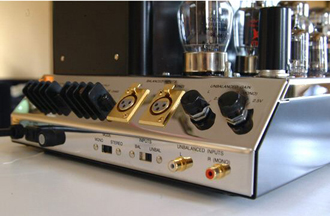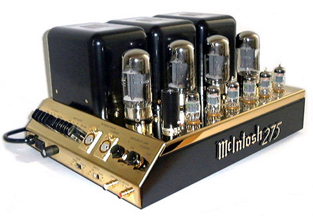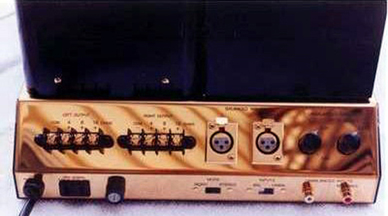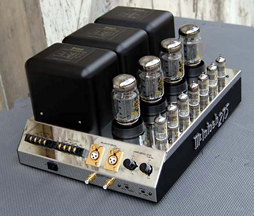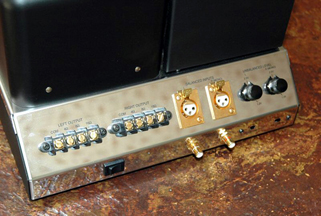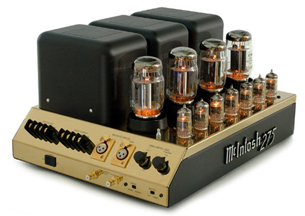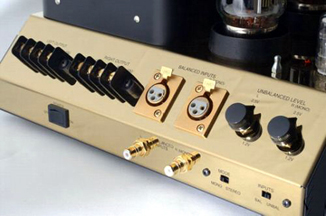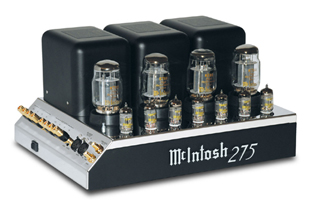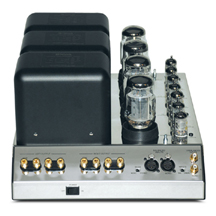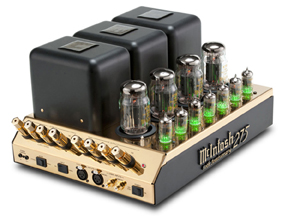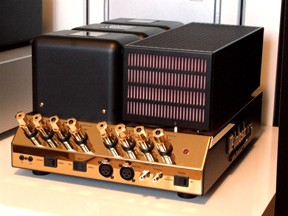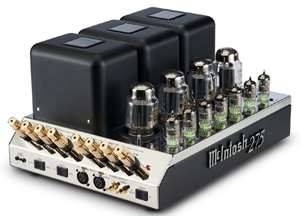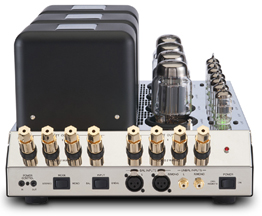To date (2017) McIntosh has produced 5 different versions of the MC275 amplifier based on electrical design, layout of the front panel and electrical specifications. Within some of those versions there are also variations - cosmetic differences.
With only a couple of exceptions, each of these versions have been known as MC275. McIntosh had a different stock number for each version and variation, but from a branded aspect, all are known as MC275.
Along the way there became a need to differentiate the various iterations of the amplifier. One way or another, these were given the unofficial “Mark” designation. However, the early use of this system was different than what has been settled on later. So, some of the older information about a particular “MK” unit may no longer be valid.
****************************************************
MC275: (
1961 ~ 1970) Chromed steel chassis. Point-to-point wiring.
(450 v power supply). Tubes: 4-
KT88/6550 output, 1-
12AX7, 2-
12AU7, 2-
12AZ7, 2-
12BH7. S/N: 10,001~10,147 & 100E1~572E9
Specifications: 16-40kHz (+0,-0.1dB). Distortion: 0.5%. Noise & Hum: -90 dB. Output impedance: 4, 8, 16 67 and 600 ohms.
MC275 “Spotting features”:
1. Octal output on front angled panel.
2. Terminal strips are vertical.
3. Gain controls.
4. Balance control.
5. Stereo/Twin Amp/Mono switch.
6. Power cord is on the vertical front panel and fuse is on the angled front.
7. 117/125V Line Voltage switch.
8. Stereo, Twin and Mono audio inputs.
9. Convenience outlet on vertical front panel.
****************************************************
MC275 CE: (
Gordon Gow Commemorative Edition): (
1993 ~ 1998) Chromed steel chassis. Gordon Gow badge. Hybrid point-to-point and PCB wiring. Balanced inputs in addition to unbalanced inputs.
(450 v power supply). Tubes: 4-
KT88/6550 output, 3-
12AX7A, 4-
12AZ7. S/N: E1001~E????
Specifications: 20-20kHz (+0,-0.2dB). Distortion: 0.5%. Noise & Hum: -100 dB. Output impedance: 4, 8, 16 ohms. Damping factor greater than 10.
MC275 CE “Spotting features”:
1. Side
Gordon Gow Commemorative Edition badge.
2. Gain controls.
3. Unbalanced inputs on far right-hand side of the vertical front.
4. Power cord and fuse are on the vertical front.
5. Convenience outlet on vertical front panel.
6. Terminal strips are horizontal.
****************************************************
MC275 SS [MK III]: (
1997 ~ 1998) Stainless steel chassis. Same design as
CE.
(450 v power supply). Tubes: 4-
KT88/6550 output, 3-
12AX7A, 4-
12AZ7. S/N: ??1001~?????
Specifications: 20-20kHz (+0,-0.2dB). Distortion: 0.5%. Noise & Hum: -100 dB. Output impedance: 4, 8, 16 ohms. Damping factor greater than 10.
MC275 [MK III] “Spotting features”:
1. No
Gordon Gow Commemorative Edition badge.
2. Gain controls.
3. Unbalanced inputs on far right-hand side of the vertical front.
4. Power cord and fuse are on the vertical front.
5. Convenience outlet on vertical front panel.
****************************************************
MC275 G: (
1998~1999) Titanium gold stainless steel chassis. Same design as
CE.
(450 v power supply). Tubes: 4-
KT88/6550 output, 3-
12AX7A, 4-
12AZ7. S/N: MC275G-01~MC275G-71
Specifications: 20-20kHz (+0,-0.2dB). Distortion: 0.5%. Noise & Hum: -100 dB. Output impedance: 4, 8, 16 ohms. Damping factor greater than 10.
MC275 G “Spotting features”:
1. Gold finish.
2. Gain controls.
3. Unbalanced inputs on far right-hand side of the vertical front.
4. Power cord and fuse are on the vertical front.
5. Convenience outlet on vertical front panel.
6. Silver McIntosh 275 emblem.
****************************************************
MC275 [MK IV]: (
2004 ~ 2006) Stainless steel chassis.
Changes: Power on/off switch added. Power cord moved to a socket in the rear. Changes to the vertical and angled front panels. Printed Circuit Board wiring.
(450 v power supply). Tubes: 4-
KT88/6550 output, 3-
12AX7A, 4-
12AT7. S/N: VN1001~VN????
Specifications: 20-20kHz (+0,-0.2dB). Distortion: 0.5%. Noise & Hum: -100 dB. Output impedance: 4, 8, 16 ohms. Damping factor greater than 14.
MC275 [MK IV] “Spotting features”:
1. Power on-off switch.
2. Gain controls.
3. Unbalanced inputs right-center on the vertical front.
4. Power cord socket and fuse are on the rear panel.
****************************************************
MC275 [MK IV] GOLD: (
200? ~ 200?) Stainless steel chassis with gold finish. Same design as
MC 275 [MK IV].
(450 v power supply). Tubes: 4-
KT88/6550 output, 3-
12AX7A, 4-
12AT7. S/N: VR1001~VR????
Specifications: 20-20kHz (+0,-0.2dB). Distortion: 0.5%. Noise & Hum: -100 dB. Output impedance: 4, 8, 16 ohms. Damping factor greater than 14.
MC275 [MK IV] GOLD “Spotting features”:
1. Power on-off switch.
2. Gain controls.
3. Unbalanced inputs right-center on the vertical front.
4. Power cord receptacle and fuse are on the rear panel.
5. Gold finish.
6. Silver McIntosh 275 emblem.
****************************************************
MC275 [MK V]: (
2009 ~ 2012) Stainless steel chassis.
Changes: RoHS. Gain controls eliminated. Early small 5-way plastic binding posts changed to gold metal in later production. Changes to the vertical and angled front panels.
(450 v power supply). Tubes: 4-
KT88/6550 output, 3-
12AX7A, 4-
12AT7. S/N: WM1001~WM????
Specifications: 20-20kHz (+0,-0.5dB). Distortion: 0.5%. Noise & Hum: -100 dB. Output impedance: 4, 8, 16 ohms. Damping factor greater than 14.
MC275 [MK V] “Spotting features”:
1. No gain controls.
3. Unbalanced inputs on far right-hand side of the slanted front panel.
4. 5-way speaker binding posts.
5. 5-way speaker binding posts.
6. Power cord socket and fuse are on the rear panel.
****************************************************
MC275 50th Anniversary: (
2012 ~ 2016) Stainless steel chassis with gold finish.
Changes: Large WBT gold metal speaker binding posts. New design – new output transformers. Sentry Monitor sequential testing/lighted bases for small tubes. Feedback taken from the speaker side of the output autoformer (all previous versions the feedback is from the amp side of the output transformer). Changes to the vertical and angled front panels. Power control added. Power indicator light added.
(490 v power supply). Tubes: 4-
KT88/6550 output, 3-
12AX7A, 4-
12AT7. S/N: ABH1001~ABH????
Specifications: 20-20kHz (+0,-0.5dB). Distortion: 0.5%. Noise & Hum: -105 dB. Output impedance: 4, 8, 16 ohms. Damping factor greater than 22.
MC275 50th Anniversary “Spotting features”:
1. McIntosh 275 50th Anniversary badge.
2. Large 5-way speaker binding posts on angled front panel.
3. All other connectors and controls are on the vertical front panel.
3. Unbalanced inputs on the right of the vertical front.
4. Power cord socket and fuse are on the rear panel.
5. Stainless Steel chassis with gold finish.
6. Output tubes are recessed.
7. Small tube light-up feature.
8. Power Control In/Out.
9. Power-on indicator.
10. Gold McIntosh 275 emblem.
****************************************************
MC275 [MK VI]: (
2012 ~ Current) Stainless steel chassis. Same design as
MC275 50th Anniversary.
(490 v power supply). Tubes: 4-
KT88/6550 output, 3-
12AX7A, 4-
12AT7. S/N: ABP1001~ABP????
Specifications: 20-20kHz (+0,-0.5dB). Distortion: 0.5%. Noise & Hum: -105 dB. Output impedance: 4, 8, 16 ohms. Damping factor greater than 22.
MC275 [MK VI] “Spotting features”:
1. Large 5-way speaker binding posts on angled front panel.
2. All other connectors and controls are on the vertical front panel.
3. Unbalanced inputs on the right of the vertical front.
4. Power cord receptacle and fuse are on the rear panel.
5. Output tubes are recessed.
6. Small tube light-up feature.
7. Stainless steel chassis.
8. Power Control In/Out.
9. Power-on indicator.
****************************************************
The McIntosh Compendium - More
complete information on each of the various MC275 versions can be found:
Here
...........(Information on the MC275G can be found:
Here)
...........Excel Spreadsheet with differences:
Here
If you have additions or corrections, please send them to:
VintageMacPDX@gmail.com
Thanks!
Larry Hodson - VintageMac
.


